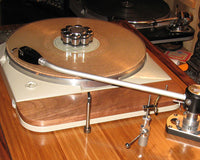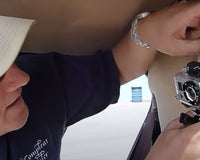Hey everyone, Ian here. Welcome to the workshop.
Let’s talk about that old turntable in your parents’ attic. That pair of bulky, wood-grain speakers you found at the thrift store for $50. What's the difference between that gear and a $5,000 audiophile system?
You might think it’s all about exotic components or gold-plated-everything, but the truth is often much simpler. The real enemy of great sound—the one thing separating "muddy" or "boomy" from "clear" and "precise"—is vibration.
If you're a tinkerer, a music lover, or a DIY problem-solver, you're in the right place. Over the next eight posts, I’m launching our "Hi-Fi Revival" series. We're going to take a $50 used turntable and two generations of iconic (and affordable) speakers and show you how to make them perform like high-end gear.
Our secret weapon? It’s not magic. It’s science. It’s Sorbothane®.
The Mission: Unlocking Vintage Performance
For this series, I've sourced a classic "budget audiophile" setup from the local used market:
-
The Turntable: A Technics SL-BD22. This is a fantastic, lightweight, belt-driven turntable from the 80s/90s. Its main weakness? It's so light that it's a "vibration victim," ready to pick up every footstep, rumble, and sound wave in the room.
-
The Speakers: A tale of two eras. We have a set of vintage Bose 301 Generation II speakers and a modern set of Bose 301 Generation V. Both use Bose's famous "Direct/Reflecting" design, but we'll see if the build quality has changed over the decades.
Our goal is to strategically eliminate vibration, and we'll show you how to do it at home, step-by-step.
The Core Problem: Vibration vs. Hi-Fi
In any audio system, you’re fighting a two-front war with vibration:
-
Vibration Victims (The Turntable): A turntable's needle is a micro-vibration sensor. It's supposed to read tiny vibrations in a record groove. Unfortunately, it will also read unwanted vibrations—footsteps, motor rumble, and the sound from your own speakers. This is the "muddiness" and "rumble" that plagues many vinyl setups.
-
Vibration Sources (The Speakers): A speaker cone moves to create sound. But it also shakes its own cabinet and the shelf or floor it's sitting on. That surface becomes a "sympathetic resonator"—a crude, second speaker you never wanted. This is what causes "boomy" bass and "smeared" sound.
The 8-Part Plan: Our Journey to Clear Sound
Here's the full roadmap for this series. Follow along as we turn this pile of parts into a true Hi-Fi system.
-
Part 2: The Turntable Rebuild. We'll start by giving our Technics SL-BD22 a full tune-up. We're replacing the belt, dust cover hinges, and upgrading the old cartridge. Most importantly, we'll add its first two Sorbothane® upgrades: our Hi-Fi Turntable Mat (to damp the record itself) and Sorbothane® Hemispheres (to decouple the turntable's feet).
-
Part 3: The Isolation Platform. We'll build our own high-mass damping platform for under $50. We'll explore the science of mass—how a heavy granite slab combined with Sorbothane® creates a "vibration black hole" that outperforms $500 commercial platforms.
-
Part 4: The Science of Speaker Design. Before we open the speakers, we'll dive into the theory. Why are speakers built the way they are? What is cabinet resonance? What's the difference between a sealed, ported, and "Direct/Reflecting" design?
-
Part 5: Deep Dive on the Bose 301. We'll explore the history of this iconic speaker, from its Gen I origins to the modern Gen V. We'll look at the unique "Direct/Reflecting" technology and what makes it so special (and controversial).
-
Part 6: The Bose 301 Gen II Rebuild. We'll crack open the vintage pair. I'll show you how to use Sorbothane® sheets as internal constrained layer damping to deaden the cabinet walls and isolate the drivers. This is the pro-level mod that makes a good speaker great.
-
Part 7: The Bose 301 Gen V Rebuild. We'll do the same for the modern pair. How does the build quality compare? Will the Sorbothane® mods make an even bigger difference in this lighter, modern cabinet?
-
Part 8: Final Review & Listening Test. We'll put it all together. We’ll review the total cost, the difficulty, and the final results. This is where we sit back, drop the needle, and find out just how good our "$100 Hi-Fi Revival" really sounds.
This is for the tinkerers, the music-lovers, and the budget-conscious audiophiles. You don't need to spend a fortune to get incredible sound. You just need to solve the right problem.
Follow along, and let's get building.










